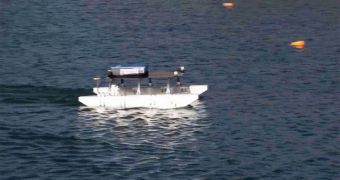Arizona State University (ASU) engineer Wolfgang Fink recently constructed a prototype robotic explorer that is shaped like a boat. The machine was designed to work autonomously, and its creator hopes to one day use it to gather data from the surface of lakes on Saturn's largest moon, Titan.
The hull protecting the watercraft from its environment is made out of Styrofoam, which gives it sufficient protection against the hazardous chemicals that await it on Titan. Lakes on the alien moon are not made out of water, but rather liquid hydrocarbons, such as methane and ethane.
What Fink wanted to create was a robot that would be able to analyze an environment, and then propel itself to where it needed to go. En route, the machine needs to be able to conduct scientific measurements covering a wide variety of parameters, pertaining to Titan's lake and atmosphere.
While a mission to the moon is not on NASA's plans for the time being, this is not stopping experts from envisioning spacecraft capable of exploring one of the most interesting celestial bodies in the entire solar system.
Despite its hazy atmosphere and frigid average temperatures, Titan is very similar to our own planet. Its atmosphere produced lightnings and thunders, and rain also occurs. The only difference is that all natural cycles on this body are based on hydrocarbons, not water.
Fink presented the new robot to experts gathered at the IEEE Aerospace Conference in Big Sky, Montana, on March 8. The machine is named Tucson Explorer II (TEX II), Space reports.
The boat weighs about 500 pounds (226.8 kilograms), plus 150 pounds (68 kilograms) of payload. The original prototype was outfitted with an imaging camera and a sonar. Fink explains that a lot of work still remains to be done, especially until the machines learn how to explore on their own.
What he wants to do is instill a sense of curiosity into swarms of such robots. This would enable the instruments to explore an interesting location, and then use the data to decide what to investigate next.
Multiple TEX II could operate together, controlled by a blimp roaming Titan's atmosphere. A centralized, larger computer could remain airborne, allowing researchers to fit more scientific equipment on each individual robot.
This means making them more autonomous. This is very important, considering that they would operate very far away from Earth. With the new technology, the prototype boat can be controlled via the Internet from virtually anywhere.
Fink does not exclude the possibility of allowing the military to take a look at his floating robot, potentially for developing new applications.

 14 DAY TRIAL //
14 DAY TRIAL //